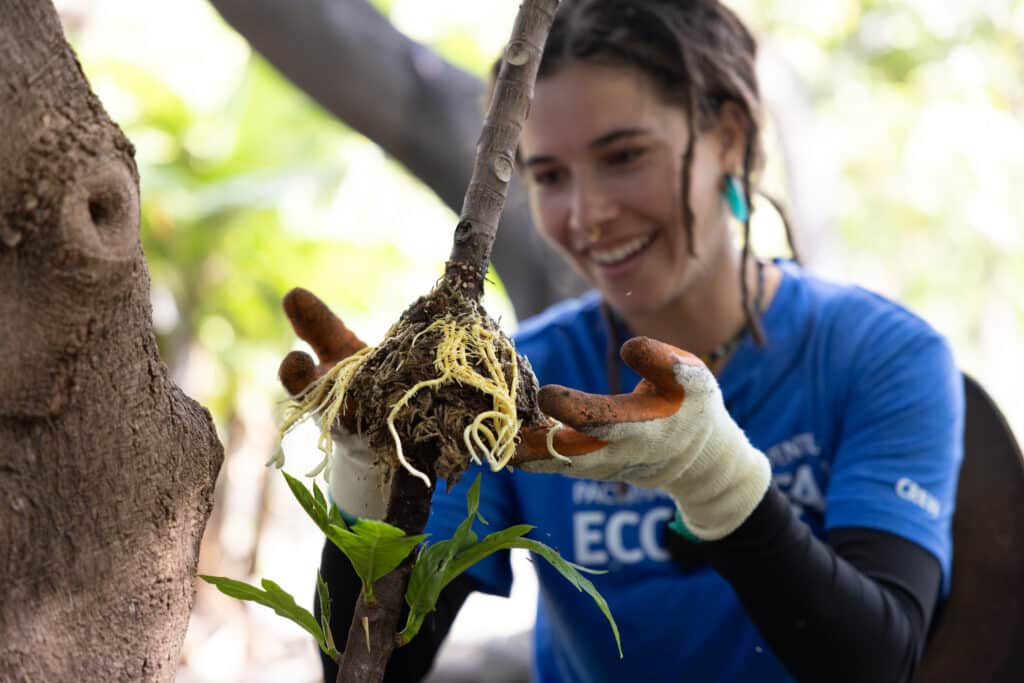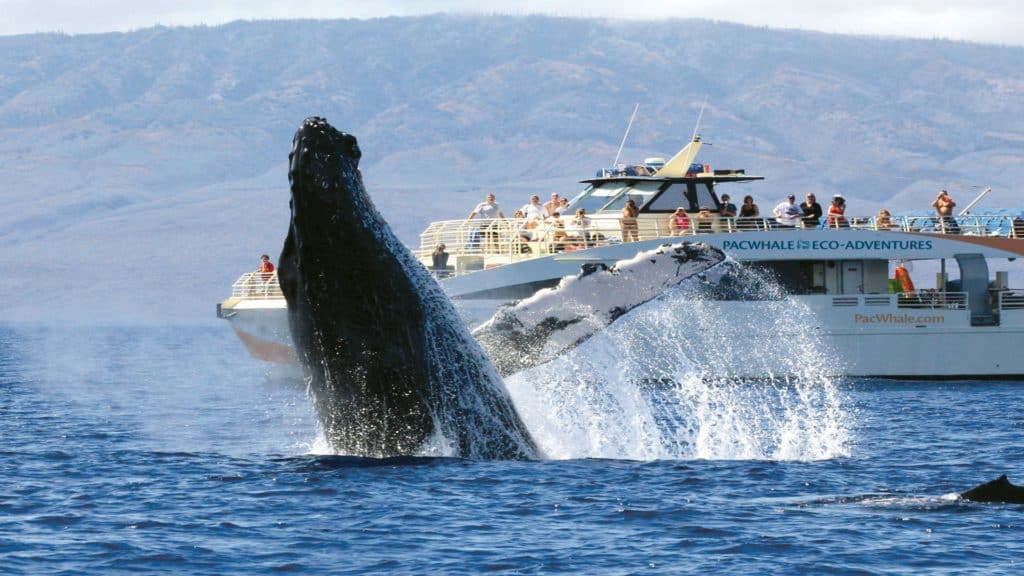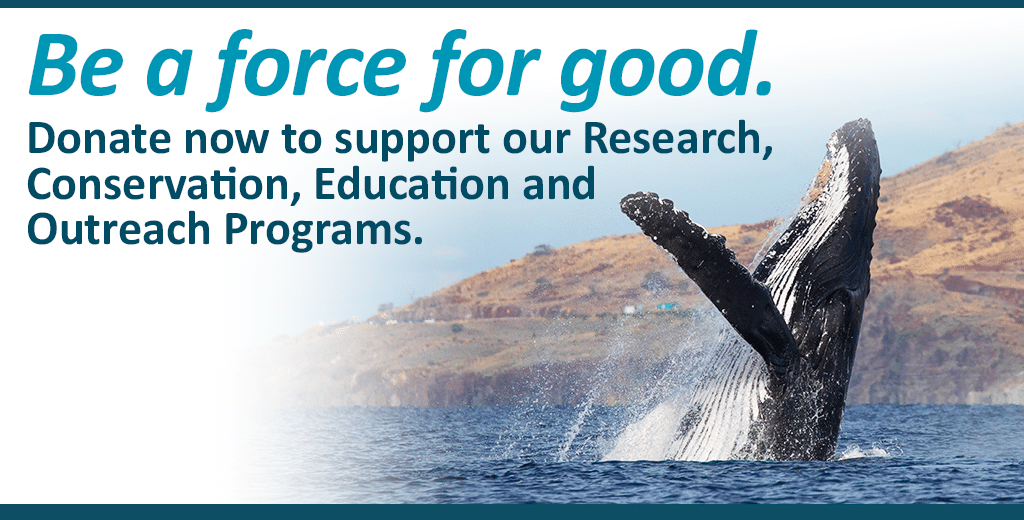Members of Pacific Whale Foundation’s Research team recently attended the 24th Biennial Conference on the Biology of Marine Mammals in Florida. This important conference brought together scientists, policymakers, managers and advocates for five days of presentations, workshops and constructive dialogue. Four team members attended the conference with support from PWF Member Grant Crosby who donated his Alaska Air miles to cover the airfare.
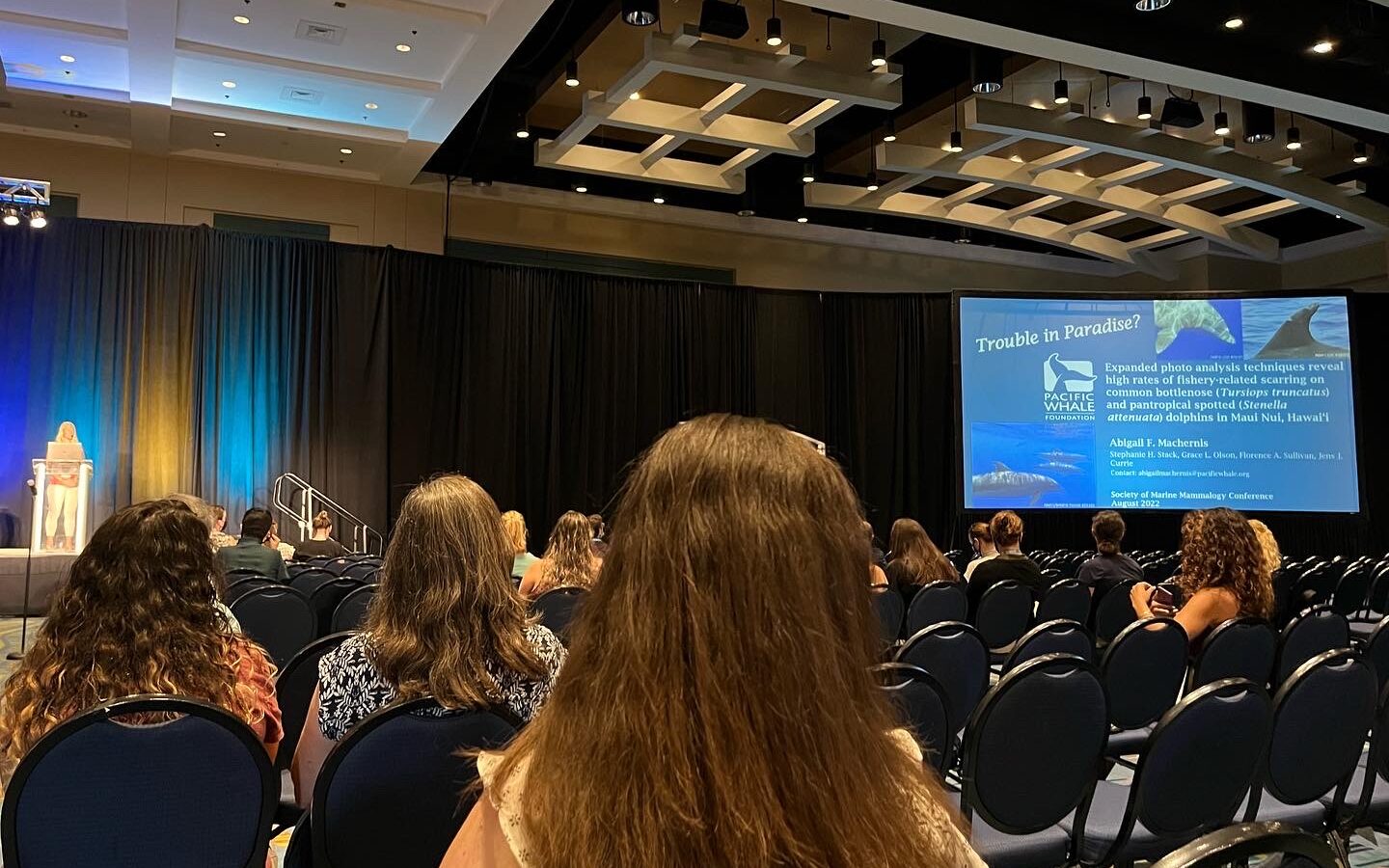
This conference is one of the largest gatherings worldwide for researchers to come together to discuss the latest in science and conservation for marine mammals.
PWF Research Biologist, Grace Olson
In an effort to be more inclusive to all attendees, this was the first fully hybrid, live-virtual conference of the Society of Marine Mammalogy. The energy at the in-person event was considerably elevated as most attendees were experiencing actual contact with other scientists and researchers for the first time in a few years.
“I was very excited to finally attend — especially after the conference had been delayed from 2021 due to the ongoing COVID-19 pandemic,” Olson continued. “During the week-long conference, I delivered a presentation on our study that assessed the spatial overlap of vessel traffic and two species of dolphins in Maui Nui, Hawai‘i.” It was particularly exciting to engage with those who sought out her work, she added.
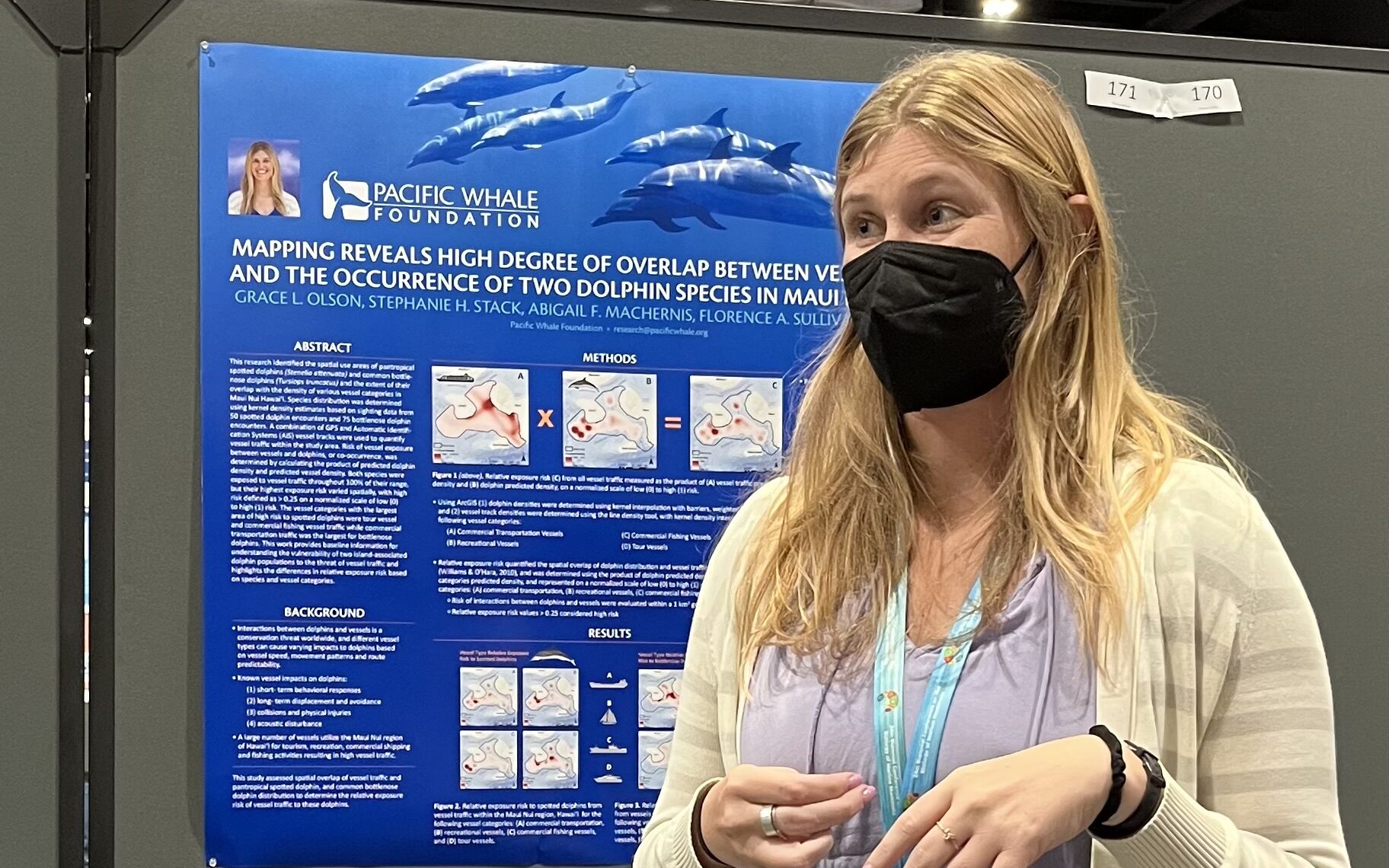
Another attendee, PWF Research Analyst Florence Sullivan, said she found it particularly inspiring to “exist in a space where scientists collaborate with managers to create informed, dynamic, practical solutions to difficult problems.”
As a presenter of PWF’s Whale and Dolphin Tracker mobile phone app, Sullivan made sure to attend other presentations focused on community science and app-based data collection. “I made connections with researchers working in Norway, Cameroon and the Caribbean, and came away with some ideas to incorporate into our app, so now it’s time to get to work” she added. “In the ‘strategies for science communication’ panel, someone shared that ‘people act when they have hope’ and the best way to create change is to ‘reconnect with your hope, and then share that hope, because it multiplies.’”
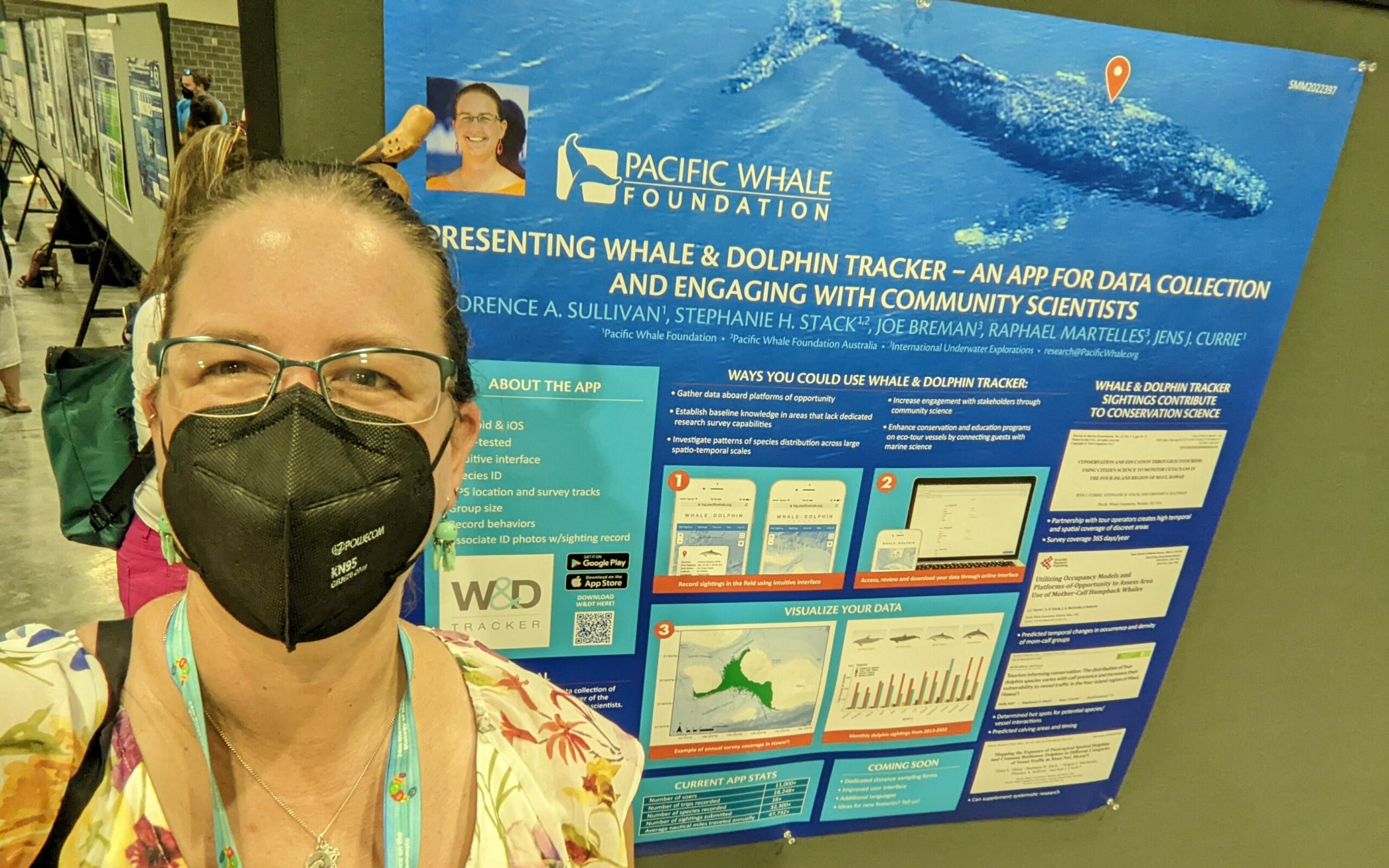
24th BIENNIAL CONFERENCE ON THE BIOLOGY OF MARINE MAMMALS
“A Sea Change: Transforming Science into Stewardship”
For more than 40 years, PWF has remained steadfast in its mission to protect the ocean through science and advocacy and inspire environmental stewardship. This stated objective, echoed in the conference theme, lies at the heart of our research and shapes the collective work of our marine science and conservation partners. This year, invited conference presenters included PWF Research team members and research collaborators. Below is the full list of presentations PWF actively contributed to (PWF researchers are identified in bold):
- Rapid weight loss in free ranging pygmy killer whales: implications for anthropogenic disturbance of odontocetes. Authors: Jens Currie, Martin van Aswegen, Stephanie Stack, Kristi West, Fabien Vivier, Lars Bejder
- The behavioural impacts of commercial swimming with whale tours on humpback whales in Hervey Bay, Australia. Authors: Stephanie Stack, Kate Sprogis, Grace Olson, Florence Sullivan, Abigail Machernis, Jens Currie
- Presenting Whale & Dolphin Tracker – An App for Data Collection and Engaging with Community Scientists. Authors: Florence Sullivan, Stephanie Stack, Joe Breman, Raphael Martelles,
Jens Currie - Trouble in Paradise? Expanded Photo Analysis Techniques Reveal High Rates of Fishery-Related Scarring on Bottlenose and Pantropical Spotted Dolphins in Maui Nui, Hawai‘i. Authors: Abigail Machernis, Stephanie Stack, Grace Olson,
Florence Sullivan, Jens Currie - Mapping Reveals High Degree of Overlap Between Vessel Traffic and the Occurrence of Two Dolphin Species in Maui Nui, Hawai‘i. Authors: Grace Olson, Stephanie Stack, Abigail Machernis, Florence Sullivan, Jens Currie
- Entanglement Scar Analysis of Humpback Whales, Megaptera novaeangliae, in Hawaiian Waters (2013 – 2021): A Comparison of Surface, Aerial, and Underwater-Obtained Imagery. Authors: Rachel Finn, Edward Lyman, Lars Bejder, Jens Currie, Martin van Aswegen, Jason Moore, Stephanie Stack, Ted Cheeseman, Marc Lammers, Sarah Wilkin, Trevor R. Spradlin
- Variability in Collisions Between Vessels and Humpback Whales (Megaptera novaeangliae) in Hawaiian Waters (1979 – 2021). Authors: Edward Lyman, Marc Lammers, Adam Pack, Amanda Bradford, David Schofield, Jens Currie, Stephanie Stack, Jeannine Rossa, Allen Tom
- Seasonally stressed? Varying metabolic biomarkers in humpback whales (Megaptera novaeangliae) in Alaska and Hawai‘i. Authors: Shannon Atkinson, Adam Pack, Heidi Pearson, Valentina Melica, Kendall Mashburn, Marc Lammers, John Moran, Suzie Teerlink, Lars Bejder, Jens Currie, Stephanie Stack, Andrew Szabo,
Kelly Cates, Martin van Aswegen - The ups and downs of humpback whale motherhood: quantifying the cost of maternal investment and calf growth on their Hawaiian breeding grounds and Southeast Alaskan foraging grounds. Authors: Martin van Aswegen, Andrew Szabo, Jens Currie, Stephanie Stack, Adam Pack, Ted Cheeseman, Shannon Atkinson, Lars Bejder
- Sensitivity and precision of unoccupied aerial system photogrammetry to assess the age structure of delphinid populations. Authors: F. Vivier, R. Wells, M. Hill, K. Yano, A. Bradford, A. Pacini, J. Ferguson, E. Leunissen, C. Booth,
J. Rocho-Levine, J. Currie and L. Bejder. - A Happy Collaboration: Basin-scale, High-throughput, AI-assisted Photo-ID Matching for North Pacific Humpback Whales. Authors: Ted Cheeseman, Katherina Audley, Astrid Frisch, Nicola Ransome, Jorge Urban, Pamela Martínez Loustalot, Jeff Jacobsen, Ester Quintana-Rizzo,Joëlle De Weerdt, Daniel M. Palacios, Craig Hayslip, John Calambokidis, Kiirsten Flynn, Phil Clapham, Christie McMillan,Jackie Hildering, Janie Wray, Nicole Doe, Caitlin Birdsall, Karina Dracott, James D. Darling, Josie K. Byington, Tasli Shaw, Mark Mallison, John K. Ford, Thomas Doniol-Valcroze, Janet Neilson, Jan Straley, Suzie Teerlink, Jen Cedarleaf, Andrew Szabo, Fred Sharpe, John Moran, Heidi Pearson, Olga von Ziegesar, Briana Witteveen, Denny Zwiefelhofer, Craig Matkin, Rachel Cartwright, Stephanie Stack, Jens Currie, Meagan Jones, Edward Lyman, Rachel Finn, Christine Gabriele, Adam Pack, Beth Goodwin, Kym Yano, Lars Bejder, Martin van Aswegen, Marie Hill, Jo Marie Acebes, Olga Filatova, Olga Titova, Evgeny Mamaev, Greg Donovan, Jeff Moore, Jay Barlow, Marilia Olio,
Hayley Newell, Ken Southerland - Determination of Total Body Length from Two Populations of Humpback Whale at Breeding Grounds in the South Hemisphere. Authors: Daniela Mello, Milton Marcondes, Kátia R. Groch, Cristina Castro, Cláudio de Oliveira
- Photo-identification of pantropical spotted dolphins in Hawaiian waters reveal long-term re-sightings, supporting the existence of island-associated resident populations. Authors: Erin Gless, Sabre Mahaffy, Grace Olson, Stephanie Stack, Jens Currie,
Robin Baird - Stock Structure, Residency, and Inter-Island Movements of Common Bottlenose Dolphins between O‘ahu and Maui Nui. Authors: Annette Harnish, Robin Baird, Jens Currie, Stephanie Stack, Tori Cullins, Lynn Opritoiu, Annie Gorgone, John Kirkpatrick
- Variation in social structure of three different stocks of island-associated bottlenose dolphins (Tursiops truncatus) around the main Hawaiian Islands. Authors: Enrico Corsi, Robin Baird, Annette Harnish, Antoinette Gorgone, Jens Currie, Stephanie Stack, Jeremy Kiszka
- Prey quality influences gray whale foraging decisions more than prey quantity. Authors: Lisa Hildebrand, Kim Bernard, Florence Sullivan, Rachael Orben, Leigh Torres
- Environmental drivers of nearshore fine-scale aggregations of zooplankton prey during the peak foraging season of Pacific Coast Feeding Group gray whales. Authors: Allison Dawn, Lisa Hildebrand, Florence Sullivan, Leigh Torres
According to PWF Research Biologist Abigail Machernis, the 2022 SMM conference was full of optimism and inspiration. “Many of the in-person conference attendees expressed how exciting it was to reconvene in person again to share our work,” she revealed.
Machernis, who is responsible for curating PWF’s Hawai’i humpback whale catalog, which is vital to ongoing threat mitigation efforts facing these whales, said she was also drawn to one of the larger topics presented at the conference: the blight of the critically endangered North Atlantic right whale (NARW) at risk from continued entanglement in fishing gear and vessel strikes. “Although PWF research does not directly focus on this species, the whales and dolphins in our region face similar threats,” she explained. “As such, many of the research techniques and lessons learned from the NARW can be applied directly to our work.”
Olson agreed, adding that many of the presentations were focused on human-based threats facing marine mammal populations worldwide. “To help with conservation and protect species from these threats, many aspects of the conference focused on science communication,” she elaborated. “It was reinforced that, as scientists, we need to get research out to the general public to raise awareness and encourage change. I hope to be able to connect with the public and share our work at PWF in a way that can inspire others.”
Virtually attending the conference, PWF Research Assistant Elizabeth Beato commented on the incredible opportunity it provided in gaining insight into how scientists around the world are approaching similar threats to marine mammals in various ways. “Attending presentations, speed talks and poster sessions focusing on the same species that PWF studies, both the same populations here in Hawai‘i as well as other populations around the world, sparks new ideas to apply to our current research projects. It allows us the opportunity to investigate various methods and approaches to answering questions about threats to our local populations of whales and dolphins in Maui Nui,” she explained. “I am grateful for the opportunity to gain a better understanding of research that is currently in the works around the world. Listening to the various obstacles and solutions other scientists have encountered, allows PWF to learn from these and solve potential obstacles within our own datasets and studies.”
Regarding the conference’s success in illuminating new study results and measures to help mitigate several ongoing threats to cetaceans worldwide, Sullivan concurred with the overarching takeaway PWF attendees experienced, “My hope from this conference is that we are not alone in our care for our ocean,” she concluded. “There are so many excellent people working in so many places along the spectrum, from understanding biological functioning to ecosystem level cascades to the creation of global policy. Together, if we move forward and choose to act, we can make a difference.”
Learn more about PWF’s Research program. Donate, become a Member or to discover other ways you can help PWF protect the ocean through science and advocacy.
